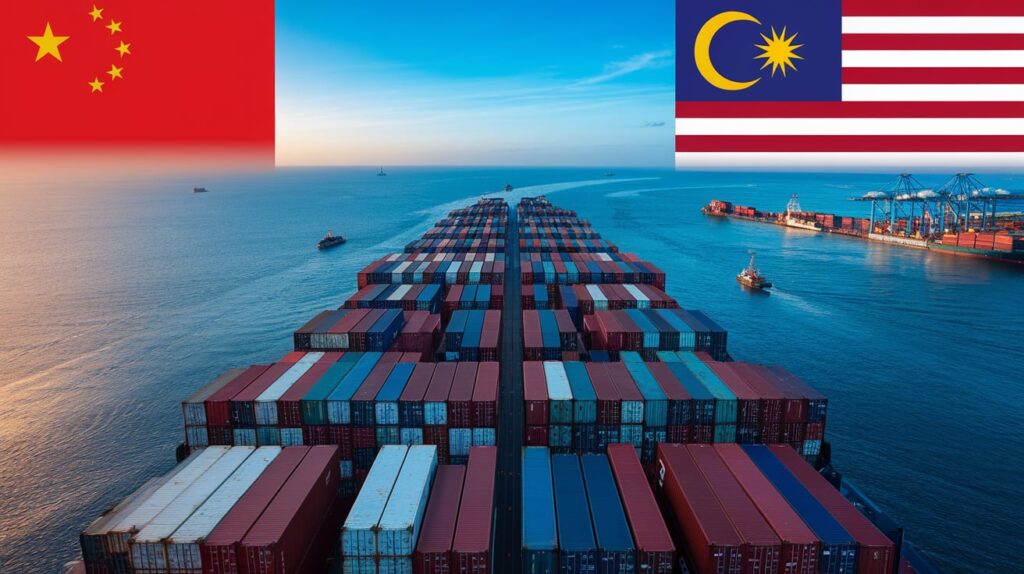- By TOP CHINA FREIGHT
- September 22, 2025
- Sea Freight, Shipping
Table of Contents
Sea freight China to Malaysia is one of the most cost-effective and reliable options for both businesses and individual importers. With growing trade between these two countries, understanding transit times, shipping costs, and customs procedures is essential for smooth supply chain operations. In this guide, we will explore all key aspects, including shipping methods, pricing, transit schedules, documentation, and tips to optimize your import operations.

What Are the Main Shipping Methods from China to Malaysia?
When shipping from China to Malaysia, companies have multiple options. Choosing the right method depends on budget, cargo type, and delivery urgency.
| Method | Cost | Transit Time | Pros | Cons |
|---|---|---|---|---|
| FCL Sea Freight | Low | 12–20 days | Cost-effective, full container | Requires full container |
| LCL Sea Freight | Medium | 15–25 days | Flexible for smaller shipments | Slower, risk of delays |
| Air Freight | High | 3–7 days | Fast, secure | Expensive, limited volume |
| Rail Freight | Medium–High | 16–22 days | Faster than sea for certain routes | Limited direct connections |
Sea freight remains the most economical solution for most importers, particularly for bulk or high-volume shipments.
How Much Does Sea Freight China to Malaysia Cost?

The cost of sea freight China to Malaysia depends on container size, cargo type, and port of origin/destination.
| Container Type | Typical Cost (USD) | Notes |
|---|---|---|
| 20ft FCL | 1,200–1,800 | Suitable for small to medium cargo |
| 40ft FCL | 2,000–3,000 | Most common for larger shipments |
| LCL (per CBM) | 50–80 | Flexible but slower |
Costs can fluctuate based on seasonality, shipping line surcharges, and fuel adjustments. Negotiating with a reliable China shipping forwarder can help secure competitive rates.
What Are the Key Ports for Sea Freight in China and Malaysia?
Major Chinese ports for shipments to Malaysia include:
- Shanghai
- Ningbo
- Shenzhen
- Guangzhou
- Xiamen
Major Malaysian ports include:
- Port Klang
- Tanjung Pelepas
- Penang
- Johor Port
Selecting the nearest port to your supplier in China and final delivery location in Malaysia can reduce inland transport costs and transit time.
Why choose rail freight over sea or air transport?
Cutting transit times nearly in half.
Saving 40–60% in shipping costs.
Trains produce 80% fewer CO₂ emissions compared to planes.
Rail avoids port congestion and flight cancellations.
How Long Is Sea Freight from China to Malaysia?
Transit times for sea freight China to Malaysia vary by shipping line, route, and weather conditions:
| Route Example | Transit Time (Days) |
|---|---|
| Shanghai – Port Klang | 12–15 |
| Shenzhen – Port Klang | 13–16 |
| Ningbo – Tanjung Pelepas | 14–17 |
| Xiamen – Penang | 15–20 |
Delays can occur due to port congestion, customs inspections, or monsoon season. Planning ahead helps avoid bottlenecks.
How to Prepare Documents for Sea Freight China to Malaysia

Proper documentation ensures smooth customs clearance. Required documents typically include:
| Document | Purpose |
|---|---|
| Commercial Invoice | Confirms transaction value and goods description |
| Packing List | Details contents and quantity of each package |
| Bill of Lading (B/L) | Legal proof of shipment |
| Certificate of Origin | Confirms country of manufacture |
| Import License (if required) | Regulatory compliance for restricted goods |
Additionally, labeling and packaging must comply with Malaysian customs standards to prevent delays.
What Goods Are Commonly Shipped from China to Malaysia?
Importers frequently ship:
- Electronics and consumer gadgets
- Machinery and spare parts
- Textiles and apparel
- Furniture and home décor
- Industrial raw materials
These goods benefit from cost-effective sea freight rates, especially in FCL shipments, which maximize shipping volume and reduce per-unit cost.
How to Optimize Sea Freight Costs?
Use LCL consolidation if you do not have a full container.
Long-term relationships can secure volume discounts.
Avoid peak seasons like Chinese New Year when rates surge.
Efficient packing reduces the number of containers needed.
Different ports may offer cheaper handling fees or shorter transit routes.
Sea Freight vs Air Freight vs Rail Freight: Which Is Best?
| Shipping Method | Cost | Transit Time | Suitability |
|---|---|---|---|
| Sea Freight | Low | 12–20 days | Bulk shipments, non-urgent |
| Air Freight | High | 3–7 days | Urgent or high-value goods |
| Rail Freight | Medium–High | 16–22 days | Large shipments to regions with rail connections |
Case Study: Electronics Import from Shenzhen to Port Klang

Shenzhen to Port Klang. By consolidating shipments and using a trusted freight forwarder:
- Cost Savings: 15% compared to standard FCL quotes
- Transit Time: 14 days, slightly faster due to port selection
- Customs Clearance: Smooth due to complete documentation
This demonstrates how strategic planning optimizes sea freight China to Malaysia efficiency.
Conclusion
Shipping via sea freight China to Malaysia is ideal for businesses looking to balance cost and transit time. By selecting the right container, optimizing documentation, and partnering with an experienced freight forwarder, importers can minimize risks, reduce expenses, and ensure timely delivery. Understanding ports, transit times, and best practices is crucial for smooth logistics operations.
Need a Shipping Quote?
If you want expert guidance and peace of mind, our team is ready to assist.
TJ China Freight offers tailored solutions to help businesses of all sizes ship more reliably from China.

FAQ
Q1:What is the cheapest sea freight option?
FCL is generally the most economical for large shipments, while LCL suits smaller loads.
Q2:How long does it take for sea freight from China to Malaysia?
Transit typically ranges from 12–20 days depending on the route and port.
Q3:Can I track my shipment?
Yes, carriers and freight forwarders provide online tracking for visibility.
Q4:What documents are required for Malaysian customs?
Commercial invoice, packing list, bill of lading, and certificate of origin are essential.
Q5:Are there seasonal price fluctuations?
Yes, peak periods like Chinese New Year may increase freight costs.
